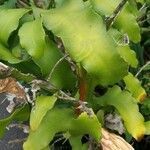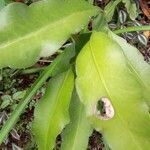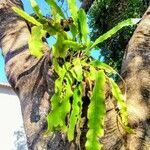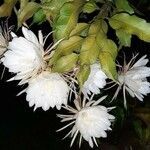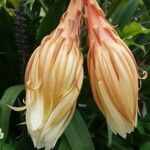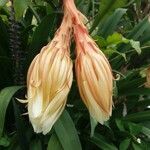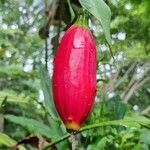Shrubs epiphytic, freely branched, 2-6 m tall, with aerial roots. Old stems and basal extension shoots terete, to 2 m or more, woody; branches numerous, dark green, laterally flattened, leaflike, lanceolate to oblong-lanceolate, 15-100 × 5-12 cm, glabrous, base cuneate, attenuate, or stalked, margin undulate to deeply crenate, apex acute to acuminate; midrib 2-6 mm wide, stout. Areoles small, spineless. Flowers nocturnal, fragrant, funnelform, 25-30 × 10-27 cm. Receptacle tube 13-18 cm, base green, 4-9 mm in diam., slightly angled, with triangular to lanceolate scales 3-10 mm. Sepaloids often recurved, pale green or pinkish red, linear to oblanceolate. Petaloids white, oblanceolate to obovate, 7-10 × 3-4.5 cm. Filaments white, 2.5-5 mm; anthers cream, 3-3.5 mm. Style white, 20-22 cm; stigmas 15-20, cream, narrowly linear, 1.6-1.8 mm. Fruit rare, purplish red, oblong, ca. 16 × 5.7 cm. Seed 2-2.5 × ca. 1.5 mm. Fl. Jun-Oct.
More
An evergreen succulent plant. It grows 2 m high. The stems are cylinder shaped. The branches are flat and notched. They are 15-40 cm long by 5-6 cm wide. They are wavy along the edge. It does not have spines. It does not have leaves. The flowers are white and like a water-lily flower. They come out at night.
It is a tropical plant. It grows in evergreenforests in central America between 75-2,000 m above sea level. In China it grows between 1,000-1,200 m altitude in Yunnan. It suits light, sandy, well-drained soils. It is grown in an open, sunny position. It is resistant to drought but damaged by frost.
